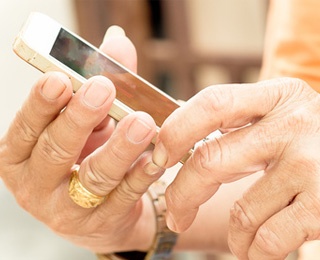Published: September 30, 2016
 Do you have a smartphone? Maybe you’re even reading this blog on one. According to the Pew Research Center, 68% of Americans have smartphones, and 45% have tablet computers. The percentage of adults that use them seems to get smaller as age increases, but the rate of use among older adults continues to rise dramatically faster than younger age groups. They become more commonplace every day.
Do you have a smartphone? Maybe you’re even reading this blog on one. According to the Pew Research Center, 68% of Americans have smartphones, and 45% have tablet computers. The percentage of adults that use them seems to get smaller as age increases, but the rate of use among older adults continues to rise dramatically faster than younger age groups. They become more commonplace every day.
If you have a smartphone, you know it has many functions. One device can serve as your phone, camera, calculator, alarm clock and even a flashlight! And if your children or grandchildren are anything like mine, their primary means of communication seems to be by text message. This is so much easier with a smartphone versus a flip phone!
The 2 most common types of smartphones are the Apple iPhone or one of the many Android devices available. I’m going share some tips for iPhones, since that is familiar territory for me. And if anyone comes back with a question, I might even be able to come up with an answer. (Disclaimer: I was not among the iPhone users camping out to get the first round of the new model. I’m still working with an iPhone 6. I think I’ll let them take some time to work the bugs out.)
There are a multitude of articles about apps that you might find useful, including one written by my friend, Molly Kavanaugh. So let’s focus on some of the features that come built into your phone.
Swipe from your Start Screen
Swipe your screen from the bottom up, and you’ll find a number of handy tools, like the calculator, flashlight, timer and more. You’ll also see some often-used buttons at the top. Make sure WiFi is turned on if you have that service at home to minimize use of your data plan. And a helpful tip if you need to charge your phone quickly? Turn on Airplane mode, and it will charge much faster. Just be sure to remember to turn it off when you’re done.
Swipe down from the top for a quick glance at today’s schedule. And you can add widgets for other features that you use often.
If your eyes are over 50 (like mine), it might help to know how to adjust settings like text and button size. You can even set your phone to emit light instead of noise when a new call is coming in. And for some, a stylus makes using the keyboard easier and more accurate.
Taking Better Photographs
The cameras built into smartphones seem to get better with every update. And this camera is amazingly portable. You can take regular photos, video, and even panorama shots. Here are some great tips for getting better pictures with your phone.
- You’ll get a sharper image if you get as close as possible to your subject, instead of using the zoom feature.
- Brighten your photo by tapping the lightest part of the screen before snapping the picture.
- Take a better selfie by holding the phone high above you.
- If you prefer to click a button to take your picture, use the volume up or volume down buttons to take a photo--as long as the camera app is open.
- If you hold the capture button down, it will take a series of rapid photos, which may help you capture just the right moment.
- You can lock the focus and exposure by pressing and holding your finger on the screen until the yellow square appears and blinks twice. A yellow icon and “AE/AF Lock” will appear at the bottom of the screen confirming that you’ve locked in the exposure and focus. It will stay that way until you’re done taking the photo.
Odds and Ends
Need a level to make sure a picture is hanging perfectly straight? Find your compass app - it may be under a folder for Utilities. From the right side, swipe left. Now you have a simple level.
To see the timestamp on a text message, swipe from the left side to the right.
More and more people (including older adults) are giving up landlines and going exclusively to cell phone use. Eliminating one phone bill could make the smartphone a more affordable option. And yes, you can dial 911 from your smartphone in most areas. It’s important to keep your smartphone charged regularly if it is your primary telephone.
If you have any other useful smartphone tips to share, please comment below.





